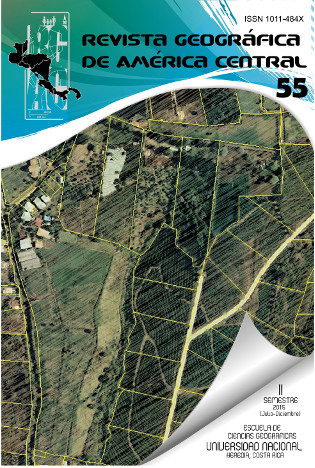THE GEOSYSTEMIC THEORY IN GEOMORPHOLOGICAL RESEARCH: A THEORETICAL-CONCEPTUAL APPROACH
DOI:
https://doi.org/10.15359/rgac.2-55.2Keywords:
systemic approach, application, physical geographyAbstract
The geosystemic theory is strongly embedded in Physical Geography, especially in the field of geomorphological research. This theory seeks to accomplish its analysis through the cause-effect relation of the elements that compose the Earth system, and it also attempts to explain how these elements are materialized in time and space. This article aims at making a theoretical and conceptual discussion on geosystemic theory and its development within the geomorphological research, thus making a reflection on the potential and weaknesses presented by this theory. We emphasize; however, the importance of this theory to guide land occupation considering the physical and environmental attributes and its dynamics in order to establish a less onerous nature and human society action that use these spaces.
References
Ab’Sáber, A. N. (1969). Um conceito de geomorfologia a serviço das pesquisas sobre o Quaternário. São Paulo, Brasil: Universidade de São Paulo, Instituto de Geografia.
Bertalanffy, L. V. (1973). Teoria Geral dos Sistemas. Petrópolis: Vozes.
Bertrand, G. (1971). Paisagem e Geografia Física global: esboço metodológico. Caderno de Ciências da Terra. São Paulo, Brasil, 27.
Bertrand, G. (2004). Paisagem e Geografia Física global: esboço metodológico. RA’E GA - O Espaço Geográfico em Análise. Curitiba, Brasil, 8, 141-152.
Christofoletti, A. (1997). Impactos no meio ambiente ocasionados pela urbanização no mundo tropical. Natureza e Sociedade Hoje. São Paulo, Brasil: Editora Hucitec, 3-97.
Christofoletti, A. (1999). Modelagem de sistemas ambientais. São Paulo, Brasil: Edgard Büchler.
Corrêa, A. C. de Barros. (2004). Unidades geoambientais do Recife. Trabalho apresentado na disciplina Metodologias de Pesquisa em Geografia Física. Recife, Departamento de Ciências Geográficas, UFPE, 7 p. (mimeogr.).
Girão, O. (2007). Análise de Processos Erosivos em Encostas na Zona Sudoeste da Cidade do Recife – Pernambuco. Tese de doutorado. Universidade Federal do Rio de Janeiro, CCMN. Brasil. (pp.305)
Hack, J. T. (1960). Interpretation of erosional topography in humid temperate regions. American Journal of Science, 258, 80-97.
Marques, R. (2008). A abordagem sistêmica e os estudos geomorfológicos: algumas interpretações e possibilidades de aplicação. Revista Geografia (Londrina), 17(2), 67-87
Mendonça, F. (1989). Geografia física: Ciência humana? São Paulo, Brasil: Contexto.
Monteiro, C. A. F. (1978). Derivações Antropogênicas dos Geossistemas Terrestres no Brasil e Alterações Climáticas: perspectivas urbanas e agrárias ao problema da elaboração de modelos de avaliação. Simpósio da Comunidade Vegetal como Unidade Biológica, Turística e Econômica, 1(15), 43-76.
Monteiro, C. A. F. (2000). Geossistemas: A história de uma procura. São
Paulo, Brasil: Contexto.
Morelli, S., Segoni, S., Manzo, G., Ermini, L. y Catani, F. (2012). Urban planning, flood risk and public policy: The case of the Arno River, Firenze, Italy. Applied Geography, 1(34), 205-218.
Rodrigues, C. (2001). A teoria geossistêmica e sua contribuição aos estudos geográficos e ambientais. Revista do Departamento de Geografia, 14(1), 69-77.
Rodriguez, J. M. M.; Silva, E. V.; Cavalcanti, A. P. B. (2004) Geoecologia das Paisagens: uma visão geossistêmica da análise ambiental. Fortaleza: Editora UFC.
Silva, M. L. (2008). Paisagem e geossistema: contexto histórico e abordagem teórico-metológica. Revista Geoambiente on-line, 3(5), 1-23.
Soares, J. P. R. y Aquino, C. M. S. (2012). Análise sistêmica: contribuição teórico metodológica e aplicações no Estado do Piuí. ACTA geográfica, 6, (13), 239-255.
Sotchava, V. B. (1977). O estudo dos geossistemas. Métodos em questão. São Paulo, Brasil.
Tricart, J. (1977). Ecodinâmica. Rio de Janeiro, Brasil: SUPREN.
Downloads
Published
How to Cite
Issue
Section
License
Proposed policy for journals offering Open Access
Authors publishing their works in the Journal acknowledge and agree to the following terms:
a) Authors retain the copyrights to their works and guarantee the Journal the right to be the first to publish their works, under the Creative Commons License Attribution-NonCommercial-ShareAlike 4.0 International, CC BY-NC-SA 4.0 International (https://creativecommons.org/licenses/by-nc-sa/4.0/deed.es), which allows others to share works upon complying with the acknowledgment of authorship and mention of the Journal as the original publisher of the work.
b) Authors are permitted to separately establish additional agreements for the non-exclusive distribution of the official edition of the work published in the Journal (for example, authors may desire to place the work in an institutional repository or incorporate it into a book that is to published elsewhere) so long they acknowledgment to recognize the Journal as the original publisher. The aforementioned additional agreements must respect the terms of the non-profit character and sharing philosophy of the original license (CC BY-NC-SA 4.0 International, https://creativecommons.org/licenses/by-nc-sa/4.0/deed.es).
c) Authors are encouraged to archive the post-print or editor/PDF version in Open Access repositories.






 REVGEO is licensed under https://creativecommons.org/licenses/by-nc-sa/4.0/deed.es
REVGEO is licensed under https://creativecommons.org/licenses/by-nc-sa/4.0/deed.es
.svg_4.png)

_(1).png)
_(1)_(1)_(1)_1.png)
(2)(1)(1)(1).png)
